Pasting ahead for Transat Jacques Vabre
Published on November 3rd, 2017
With eyes and time narrowing to the start of the 13th edition of the Transat Jacques Vabre at 13:35 (French time) on November 5, and winds of 40 knots waiting for the doublehanded teams a couple of days after, here is a review of the four classes.
A review of the monohulls: the 60ft Imoca and the Class40.
Imoca: 6 contenders, 5 foilers, 4 latest generation, 1 big favourite
There are few more relaxed skippers at the start of a Transat Jacques Vabre than Jean-Pierre Dick. The tall sailor from Nice is a top soloist, but an even more formidable double-handed specialist. No one in the history of the class can match his three victories in the Transat Jacques Vabre (2003, 2005 and 2011). He has the boat – the latest generation foiling St Michel –Virbac and the co-skipper – Yann Eliès – to match. “We have done our homework properly, we are ready,” Dick said, with a matter-of-fact calm ominous for those that would challenge them.
Along the Quai de la Réunion, where the 13 Imoca are moored, lie the other latest generation foiling boats launched in 2015: Bureau Vallée, Des Voiles et Vous, Malizia II. Initiatives-Cœur, is the old Maître CoQ, a 2010 boat with foils added by Jérémie Beyou for the Vendée Globe 2016, but Tanguy de Lamotte and Britain’s Sam Davis are a team that are as formidable – having finished 5th in the Transat Jacques Vavre 2015 in a much less capable boat – as they are likeable. It is that team factor that makes SMA, the former Macif that won the 2012-13 Vendée Globe, real challengers. If it is not a long downwind drag to Salvador, Paul Meilhat and co-skipper Gwénolé Gahinet will be in the mix.
Eliès, who finished 3rd in 2015, does not hesitate in naming SMA as their biggest rival, and perhaps pointedly names no one else. “I think SMA is the best,” he said. “We’ve done five training sessions together (in Port le Forêt), so we know them very well. It’s an older boat, yes, but…They are faster than us upwind by nearly one knot and 10 degrees higher and they go faster than us downwind in light wind, because they are lighter and have nearly a metre more mast. But in reaching, yes, there is no game. We’re the same at 15 knots of wind, but after 20 knots of wind we are faster by two, three sometimes four knots.”
Dick, forced to abandon with structural problems in 2015, casts his eye a little, but not much, wider: “Des Voiles et Vous and SMA and (after a little pause) Malizia.” Meilhat demurs modestly, saying, truthfully that their three victories in major French races this season were over much shorter distances and in conditions that favoured them, but both young skippers are impressive and on the rise.
Louis Burton and Servane Escoffier’s Bureau Vallée 2, is probably the fastest in the fleet, being the old Banque Populaire VIII that won the 2016-17 Vendée Globe, but the partners, a couple on land as well as at sea, are still learning to control their new Imoca. Boris Herrmann, the German skipper of Malizia II, is in a similar position having acquired the former Edmond de Rothschild. Des Voiles et Vous, formerly Safran, has the same skipper, Morgan Lagravière, but joined by Eric Peron they are new team.
Behind these six there should be race-within-a-race between five older generation boats from 2007: La Mie Câline – Artipôle, Bastide Otio, La Fabrique, Newrest-Brioche Pasquier and perhaps Generali, Eliès’s old boat that finished 5th in the last Vendée Globe. Concluding the fleet are Vivo a Beira (2004), privately funded by Pierre Lacaze, a banker living the dream and Famille Mary – Etamine du Lys, easily the oldest in the class (1998).
The Class40: Five contenders, but which five?
All the Quai des Antilles – where the Class 40s are moored – agrees there are probably five boats that can win it, but few seem to agree on which five.
The Class40 is the largest (16 boats) and definitely most competitive and international fleet with no clear favourites and a host of powerful pretenders to the throne.
With the newest, more powerful boats not tamed or proven, Britain’s Phil Sharp (Imerys Clean Energy), the clear leader of the Class40 championship this season, is one name on everybody’s lips. Last year, he somehow got the boat into New York in third place in the Transat Bakerly after last-minute flights to America to get his Visa in person, a 6-hour penalty caused by missing the safety briefing, a detached forestay and the watching his mainsail being ripped in half in the final stages. He had only taken charge of it three weeks before the race and was still working on it until 03:00 on the morning of the start.
Now the boat – the former GDF Suez that won the Transat Jacques Vabre in 2013 – is an optimised stallion and Sharp has the experienced Pablo Santurde, Alex Pella’s former teammate, with him. “I don’t really see the point of entering a race unless there’s a good chance of winning the race,” Sharp said. “This year we’ve been able to get the boat properly prepared. We developed and optimised the boat and most importantly got the racing miles under the belt.”
A confident Sharp picks out just three boats: “Aïna, a brand new Mach 40 (designed) evolution of this boat. It’s not only a good boat but they are both competent skippers with a lot of ocean racing experience. Also V and B are going to be right up there as well, they’ve done a lot of racing together and the boat is very fast. They’re both faster boats than us in reaching conditions. Then there’s a brand new boat, Carac, which is a beast in strong winds, but with very good and experienced sailors on board – you can push that boat hard in strong winds and it will eat up the miles.”
Maxime Sorrel was second on V and B in 2015 and is joined this time by the experienced Antoine Carpentier this time. Louis Duc was third in 2015 on the old Carac and has only had a couple of months with Alexis Loison (making his debut, but with 10 years on the Figaro under his belt) to get to grips with his round bowed beast. Aïna’s Aymeric Chappellier and Arthur Le Vaillant are also used to vying at the front and have the radical powerful design to keep doing that.
Then come several serious outsiders like Sidney Gavignet and Fahad Al Hasni (Oman Sail) and Bertrand Delesne and Justine Mettraux (Teamwork 40). “I think nine boats can win,” Gavignet said. “If we finish in the top 6 we’ll have done a good job. There are three or four faster – but if everything goes well this boat can win.”
And we cannot talk of the Class40 podium without mentioning Halvard Mabire and his partner on land and sea, Mirand Merron, who have more miles sailing together under their belts than most of the others teams put together and “more than we can count,” Mabire, the 60-year-old president of the Class40, said. “The level is incredible, ten crews could win. But at my age, if I win is that there is something wrong.” But Campagne de France was launched in 2016 and they are not used to just making up the numbers, lying second in the Class40 championship this season. Britain’s Merron is the only previous TJV winner racing – on the 50 foot Pindar, alongside Emma Richards in 1999.
Two other duos to look out for are Olivier Cardin and Cédric Château (Région Normandie Junior Senior by Evernex) and Tom Laperche and Chrisophe Brachmann (Le Lion d’Or).
A review of the multihulls: the Multi50 and Ultimate.
There is one boat in the harbour at Le Havre that stands out, even amongst all the other prototype racing machines being primed for the start of the Transat Jacques Vabre 2017 on Sunday – it literally stands out. Maxi Edmond de Rothschild, the latest of the great Ultime-class boats coming out of the boatyards, is so big it has its own Bassin. At 23 metres wide, it was 50cm too large to fit through the docks into the Bassin Paul Vatine, where the other 37 boats are moored, so it had to stay around the corner in the Bassin de l’Eure.
This venerable port in Normandy, France, which is celebrating its 500th anniversary, has witnessed many things since it started hosting the bi-annual Transat Jacques Vabre in 1993, but nothing quite this size.
The only record Seb Josse, the 42-year-old French skipper, is interested in is how long it will take to finish. “Eight days,” he says matter-of-factly, as if the 4,350 miles to Salvador de Bahia in Brazil is short hop. The fastest finish to Salvador remains Groupama 2’s astonishing 10day 0h 38min win in 2007 in the 60ft multihull class. Josse’s best finishing time was his 11day 5 hours 3min win with Charles Caudrelier on the MOD70 trimaran Edmond de Rothschild in the 2013 edition – that time to Itajaí, Brazil.
“Compared to 2013 it’s another world,” Josse said. “It’s the size. It’s bigger, heavier, faster, but it’s also safer – the MOD70 double-handed was a little bit scary, you could’ve capsized at any time. When you are going at 30 knots in the MOD70 you are the limit of the boat, in this one you are just starting to move.”
His co-skipper, Thomas Rouxel, agrees, with some relish. “Under 30 knots, we feel very slow and like we’re stuck in glue,” Rouxel, making his debut in the race, said. “Between 30-40 it’s nice, you feel fast and it’s easy and from 40 to more it starts to be a bit intense.”
At 32 metres long, with a 35-metre mast and 650m² of sail area downwind, it is a lot of boat to handle two-handed, let alone solo – for which it has been designed. But its size and ability to the ride the waves make it more stable and safer. There may only be a tiny 4m² of hull actually in the water when reaching, but “the rudder and the foils give a lot of stability, so it’s more comfortable because you four points on the water,” Josse said.
Even though there are only three Ultimes in the race, Josse and Rouxel will not have it all their own way. They are up against two proven boats with skippers who have also won the race. Sodebo Ulitim’, skippered by Thomas Coville and Jean-Luc Nélias, is not technically a new boat, having been completely reconstructed from the old Geronimo, but Coville knows it inside and out. What he is giving away in size (31m long and 21.20m wide) and technology, he is gaining in experience. Coville, the 49-year-old skipper, smashed the record for a solo circumnavigation in December 2016. His new mark of 49d 3h 7m took 10 days 8 hours off Francis Joyon’s previous record. In July, Coville and Nélias hunted François Gabart’s new Macif all the way across the north Atlantic in The Bridge race, as they had done in 2015 in the Transat Jacques Vabre.
It will be a two-horse race because as excellent and experienced as are Lionel Lemonchois and Bernard Stamm, their ride, Prince de Bretagne, is older (2012) and out-powered. Lemonchois, the 60ft multihull winner in 2005, abandoned in the last edition on this boat.
“We are in the same position as two years ago with Macif,” Coville, who won the TJV on a 60ft Imoca monohull in 1999, said. “Except that Edmond de Rothschild is even more extreme in its design, backed by an incredible team that really knows its stuff. We, on the other hand, have a boat born from Geronimo that has evolved and done the job well. It is the best of the old generation. It will be two generations: a brand new trimaran, which is the best there is today, and another one that has matured and does the job perfectly.”
Josse and Rouxel will have to be that good as Macif to hold them off.
“We’re just at the start, it’s just two months in the water, we need one year to understand how to use it properly,” Josse said. “It’s the start of the story of this boat, we have to learn and grow up and if we sail well and there are no big technical problems or problems with the weather, we can win and we should win on paper. But in the end, we know that sometimes the story does not finish as it was written at the start.”
In the smaller multihull class, the Multi 50, of the fleet of six there are four modern new generation boats that should fight for victory. FenêtréA – Mix Buffet must start favourite. Given “muscles” by the addition of foils, but still “safe” and stable say the skippers, it is hard to look past the record of Erwan Le Roux, the winner in 2009, 2013 and 2015. With Vincent Riou (twice a winner of the IMOCA class in 2013 and 2015) as his co-skipper, they are a formidable unit.
But on paper Ciela Village, just launched and the only multi designed specifically for the use of foils, should be faster. The talk on the pontoons is that nobody knows how fast, not even its experienced skipper Thierry Bouchard who is partnering with Oliver Krauss again.
Arkema, skippered by Lalou Roucayrol is a strong contender. Since its launch in 2013 it has won only the Route des Princes but its fast boat with an even faster co-skipper, the Catalan Alex Pella. And Réauté Chocolat (ex-Actual), is in the hunt after Armel Tripon added foils. This is Tripon’s first transatlantic in a multihull, but the winner of the 2003 Mini Transat and his boat captain partner Vincent Barnaud, making his debut in the TJV have had good result this season.
The final two: Drekan Group (Eric Defert and Christopher Pratt) and La French Tech Rennes Saint Malo (Gilles Lamiré and Thierry Duprey du Vorsent), do not have foils (although the latter is big and has impressive daggerboards) and it is hard to see how they will be able to keep pace when conditions allow them to accelerate.
Race details – Entry list – Facebook
13th edition of the Transat Jacques Vabre
• Biennial doublehanded race now 24 years old
• Two founding partners: the city of Le Havre and brand Jacques Vabre
• Four classes on the starting line: Class40, IMOCA, Multi50, and Ultimate
• Starting November 5 in Le Havre (FRA) for the 4350nm course to Salvador de Bahia (BRA)
n 2013, and again in 2015, all the boats flew past Salvador de Bahia, sails filled by the trade winds of the south-east, under the tropical sun…One imagines that they dreamt of finally finishing their race in All Saints’ Bay. In 2017, it will be a reality!
After the start line and a coastal route as far as Etretat, the duos will head towards Brittany to get out of the Channel as quickly as possible, where the currents are powerful, cargo traffic dangerous, and a lot of attention is needed.
They will then enter the Bay of Biscay, where, depending on the position of the Azores anticyclone, they will either find downwind conditions, easy and fast, like for the last Vendée Globe, or tougher and slower conditions in the passage of some late autumn depressions.
Four hundred miles later, having passed Cape Finisterre, the northern Portuguese trade winds should propel them quickly towards Madeira, and then the Canary Islands, where awaiting them will be northeast trade winds, which could be strong or weak.
Passing close to the Portuguese coast, or offshore, to the east or west of the Canary Islands and then the Cape Verde islands – you have to choose the right options. The next goal is to establish your position for the crossing of the dreaded Doldrums, located a few degrees north of the equator. At this time of year, it can change position very quickly, extend or contract, because even after carefully studying of the satellite images, sudden squalls can develop and stall the competitors under a good shower without wind for hours.
This passage is crucial in the Transat Jacques Vabre racecourse. Further west… Further east… After the calms, rainy squalls, with too much or no wind… The final goal is to get out well-positioned enough to benefit first from the southeast trade winds and to cover the remaining 850 miles towards the finish,passing along the islands of Fernando de Noronha, along the coast of Brazil and finally heading northwest into the magnificent All Saints’ Bay.
This transoceanic racecourse from North to South is more demanding than a transat from East to West; it requires the skippers to have sharp tactical and strategic qualities, good weather training, to be in excellent physical condition to maintain a sustained speed in the trade winds… And to have a lot of patience to cross the equator.


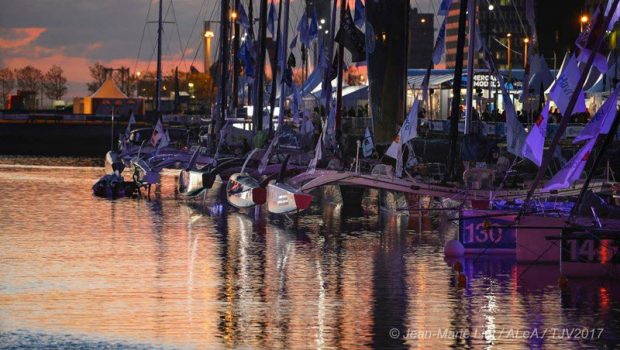

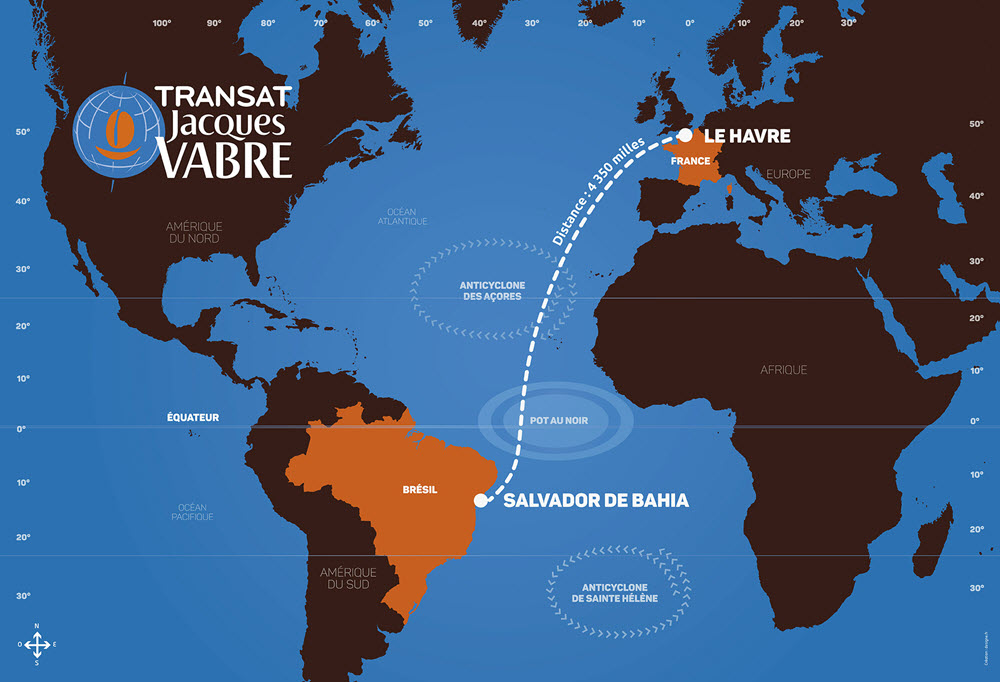

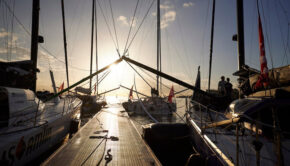
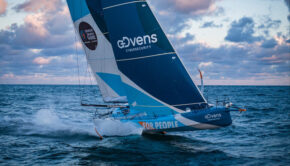
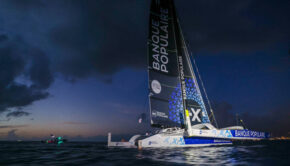
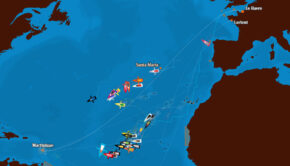
 We’ll keep your information safe.
We’ll keep your information safe.